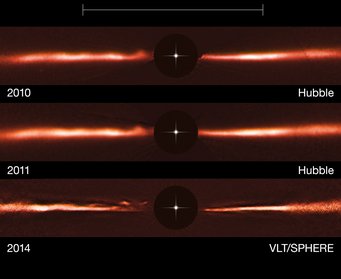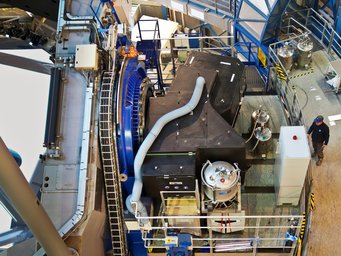Astronomers find unusual moving structures in dust disk around star
Using the instrument SPHERE and the Hubble Space Telescope, a team that includes MPIA astronomers have identified unusual moving features in the dust disk surrounding the nearby star AU Microscopii. This is the first observation of such structures changing over time, and at present, the nature and origin of the features is unclear. The features could be linked to eruptions of the star AU Mic, or to (as yet unseen) planets hidden within the dust disk. The results are being published in the October 8, 2015 edition of the journal Nature.
| Background information | Questions and Answers | Download links for images |

Bilder der Trümmerscheibe um den Stern AU Mic von 2010 (oben; Hubble-Weltraumteleskop), 2011 (Mitte; Hubble-Weltraumteleskop) und 2014 (unten; SPHERE-Instrument), die neu entdeckte, bewegte, wellenartige Strukturen zeigen.
Der schwarze Kreis in der Mitte zeigt an, wo das helle Licht des Zentralsterns künstlich abgeschattet wurde, um die Beobachtung der deutlich leuchtschwächeren Scheibe zu ermöglichen. Das Symbol in der Kreismitte zeigt die Position des Sterns an.
Die Entfernungsskala ganz oben im Bild zeigt den Durchmesser der Umlaufbahn des Planeten Neptun in unserem Sonnensystem (sechzigfacher Abstand Erde-Sonne = 60 AU). Die Helligkeit der äußeren Scheibenregionen wurde künstlich vergrößert, um dortige Strukturen sichtbar zu machen.
The star AU Mic ("AU Microscopii") in the Southern constellation Microscope, which is less than 33 light-years from Earth, is surrounded by a sizable disk made of dust, which observers on Earth can see directly edge-on. Now, the has been imaged in great detail using SPHERE, the newly installed exoplanet-and-disks imaging machine at ESO's Very Large Telescope, and previous data from the Hubble Space Telescope. For the first time, astronomers could not only identify sub-structures, but also reliably track changes within the disk: fast-moving, wave-like features that move outwards within the disk.
When the instrument team for SPHERE chose targets for their initial observations, AU Mic was a natural candidate. MPIA director Thomas Henning, who is part of the team that studied the disk, explains: “Right away, we noticed detailed structures in the disk – if you had told me a few years ago that we would be able to image disks in such detail, I wouldn't have believed you. We compared these structures with images taken by a number of colleagues and myself using the Hubble Space Telescope in 2010 and 2011.”
Henning continues: “We were in for a surprise: Yes, we were able to identify reliably a considerable number of structures in both the SPHERE and the Hubble images. But within those few years, the features had moved away from the star. For the first time, we had observed not only the structure or the spectral features of a stellar debris disks – we were watching the disk change!”
According to a preliminary analysis, which will need to be confirmed by future observations, some of the matter observed might even be on its way out of the disk altogether, with sufficient speed to leave the stellar system behind.
There is, at this moment, no complete explanation for the disk dynamics observed by the combination of SPHERE and Hubble images. AU Mic, a red dwarf star (of type M1 Ve) a little over half the diameter of the Sun, is a rather young star with an age of around 12 million years, compared to our Sun's age of 5 billion years. As is not uncommon for such young stars, AU Mic is very active, and frequently produces sizable flares: Eruptions involving the star's magnetic field, which catapult stellar plasma at high speed into the star's surroundings. It is possible that the moving features in the dust disk are caused by such stellar activity.
Another, tantalizing possibility is that the changes could be tell-tale signs of the presence of one or more giant planets in the debris disk. In that case, the motion would be due to disturbances caused by one or more planets' gravitational pull as it moves through the disk. So far, no planets around AU Mic have been detected – but this could change as search and imaging techniques improve.
In total, the surprising observations of disk changes around AU Mic provide for a whole programme of additional observations. If the researchers are very lucky, they might even be able to detect proto-planets – smaller bodies busily gathering sufficient mass for planethood – within the disk. More generally, extending observations such as these should allow for detailed comparison with simulations of such objects – and could shed light on processes of planet formation, which might have left tell-tale traces on the disk
Background information
This research described here was published as Boccaletti et al., "Fast-Moving Structures in the Debris Disk Around AU Microscopii", in the 8 October 2015 edition of Nature.
The co-authors are Anthony Boccaletti (Observatoire de Paris, CNRS, France), Christian Thalmann (ETH Zürich, Switzerland), Anne-Marie Lagrange (Université Grenoble Alpes, France; CNRS, IPAG, France), Markus Jansons (Stockholm University, Sweden; Max-Planck-Institut für Astronomie, Germany), Jean-Charles Augereau (Université Grenoble Alpes, France; CNRS, IPAG, France), Glenn Schneider (University of Arizona Tucson, USA), Julien Milli (ESO, Chile; CNRS, IPAG, France), Carol Grady (Eureka Scientific, USA), John Debes (STScI, USA), Maud Langlois (CNRS/ENS-L, France), David Mouillet (Université Grenoble Alpes, France; CNRS, IPAG, France), Thomas Henning (Max-Planck-Institut für Astronomie, Germany), Carsten Dominik (University of Amsterdam, Netherlands), Anne-Lise Maire (INAF–Osservatorio Astronomico di Padova, Italy), Jean-Luc Beuzit (Université Grenoble Alpes, France; CNRS, IPAG, France), Joe Carson (College of Charleston, USA), Kjetil Dohlen (CNRS, LAM, France), Markus Feldt (Max-Planck-Institut für Astronomie, Germany), Thierry Fusco (ONERA, France; CNRS, LAM, France), Christian Ginski (Sterrewacht Leiden, Netherlands), Julien H. Girard (ESO, Santiago, Chile; CNRS, IPAG, France), Dean Hines (STScI, USA), Markus Kasper (ESO, Germany; CNRS, IPAG, France), Dimitri Mawet (ESO, Chile), Francois Ménard (Universidad de Chile, Chile), Michael Meyer (ETH Zürich, Switzerland), Claire Moutou (CNRS, LAM, France), Johan Olofsson (Max-Planck-Institut für Astronomie, Germany), Timothy Rodigas (Carnegie Institution of Washington, USA), Jean-Francois Sauvage (ONERA, France; CNRS, LAM, France), Joshua Schlieder (NASA Ames Research Center, USA; Max-Planck-Institut für Astronomie, Germany), Hans Martin Schmid (ETH Zürich, Switzerland), Massimo Turatto (INAF–Osservatorio Astronomico di Padova, Italy), Stephane Udry (Observatoire de Genève, Switzerland), Farrokh Vakili (Université de Nice-Sophia Antipolis, France), Arthur Vigan (CNRS, LAM, France; ESO, Chile), Zahed Wahhaj (ESO, Chile; CNRS, LAM, France) and John Wisniewski (University of Oklahoma, USA).
The instrument SPHERE at ESO's VLT was co-developed by MPIA researchers and engineers.
Questions & Answers
What are debris disks and how had they been observed so far?
Debris disks such as that of AU Mic are left over from the phase of planet formation. Back then, AU Mic was surrounded by a protoplanetary disk of dust and gas, from which any of its planets (none of which have been detected so far) would have formed. In our own solar system, the Kuiper belt beyond the orbit of Neptune, which consists of thousands of smaller celestial objects (including Pluto), is a late-stage version of such a debris disk. Some of the dust has been produced by the collision of asteroid-like objects in the disk.
When astronomers observe stars, their observations are limited by the sheer distances involved. Even with cameras installed at the largest current telescopes, straightforward images of distant stars never show these objects any different from the way they would show a point source. For a debris disk, typical radii are between 10 and 100 times the distance between the Earth and the Sun, that is, between 10 and 100 astronomical units (10-100 AU). Most known debris disk have only been detected indirectly, by the infrared radiation that is produced as their dust scatters the star's light. Althoug a few disks are large enough to be seen on images, examinations of debris disks has mostly relied on studies of the rainbow-like spectra of their light.
How were the observations made - and what is the special role of SPHERE?
SPHERE combines major components that make it particular suitable for detailed imaging of such disks, which are usually hard to observe due to the bright glare of the central star: an “extreme adaptive optics system” to compensate for atmospheric turbulence (which limits telescopes' spatial resolution), a suite of components designed to physically block the light from the central star (coronagraphs), a polarimeter that can filter out reflected light (such as that scattered by dust in a disk), and a camera that is particularly suitable for high-contrast imaging and that also allows for “differential imaging”, a technique to separate the image of an object like the dust disk from noise effects.
On August 10th, 2014, the astronomers turned SPHERE's infrared camera IRDIS onto Au Mic. Highly favourable atmospheric conditions and high performance from the adaptive optics system combined to yield a superb high-contrast image, allowing the astronomers to image brightness values differing by a factor of more than 10,000 over shortest distances (points separated by half an arc second). This allowed the astronomers to image the disk between distances of 1.7 times the Earth-Sun distance (1.7 AU) to around 70 times the Earth-Sun distance (70 AU). Regions even closer to the star were blocked out mechanically to suppress stellar glare, while the outer limit was imposed by the instrument's limited field of view. In total, the disk extends out to distances of at least 200 AU.
The observations using the Hubble Space Telescope had been made earlier, in 2010 and 2011, using the telescope's imaging spectrograph STIS. In retrospect, even a comparison of the Hubble images from 2010 and 2011 shows traces of the changes that have now been detected.
What are the next steps?
Given the unclear nature of the moving features, it is essential to gain more data about the system. Follow-up observations both with the Hubble Space Telescope and with SPHERE could provide further data, and trace the further development. Measurements with the polarimeter ZIMPOL that is one of the subsystems of SPHERE could reveal the orientation of the features that are visible in the images. Observations with the millimeter/submillimeter observatory ALMA could show the amount of gas that is still contained in the debris disk; an important factor for understanding the dynamics of the disk. Monitoring of the stellar activity of AU Mic could help to prove – or disprove – the connection between the dynamics of the disk and eruptions on the star. Differential imaging techniques such as the ones for which SPHERE is optimized, using the characteristic light emitted by hydrogen atoms (Hα), could allow for the observations of planetary births within the disk.
What is new/unusual about these results?
Debris disks are expected to provide valuable clues to the formation of planets. So far, most such disks have only been observed evaluating their spectra. Images are available only for few of such disks, and this was first time when astronomers could not only identify sub-structures, but also reliably track changes within the disk: fast-moving, wave-like features that move outwards within the disk. The properties of these features, and the reason for their rapid movement, is still unclear.
Download area

Bilder der Trümmerscheibe um den Stern AU Mic von 2010 (oben; Hubble-Weltraumteleskop), 2011 (Mitte; Hubble-Weltraumteleskop) und 2014 (unten; SPHERE-Instrument), die neu entdeckte, bewegte, wellenartige Strukturen zeigen.
Der schwarze Kreis in der Mitte zeigt an, wo das helle Licht des Zentralsterns künstlich abgeschattet wurde, um die Beobachtung der deutlich leuchtschwächeren Scheibe zu ermöglichen. Das Symbol in der Kreismitte zeigt die Position des Sterns an.
Die Entfernungsskala ganz oben im Bild zeigt den Durchmesser der Umlaufbahn des Planeten Neptun in unserem Sonnensystem (sechzigfacher Abstand Erde-Sonne = 60 AU). Die Helligkeit der äußeren Scheibenregionen wurde künstlich vergrößert, um dortige Strukturen sichtbar zu machen.
Download figure 1


